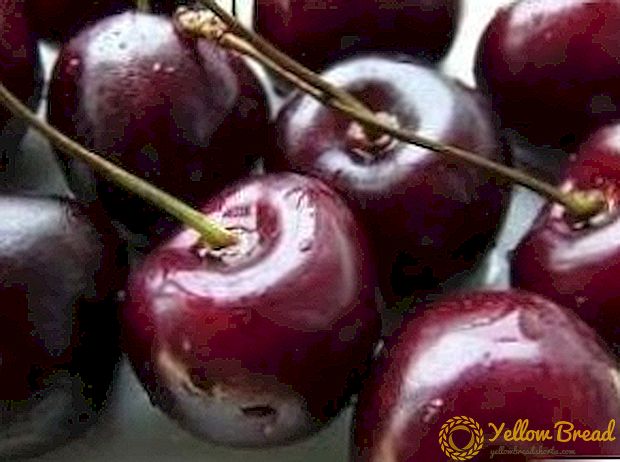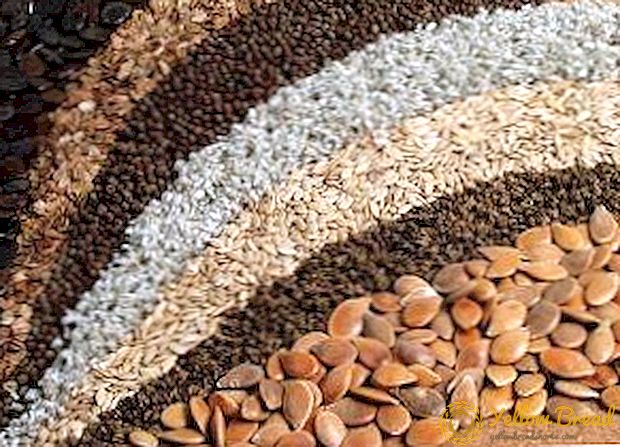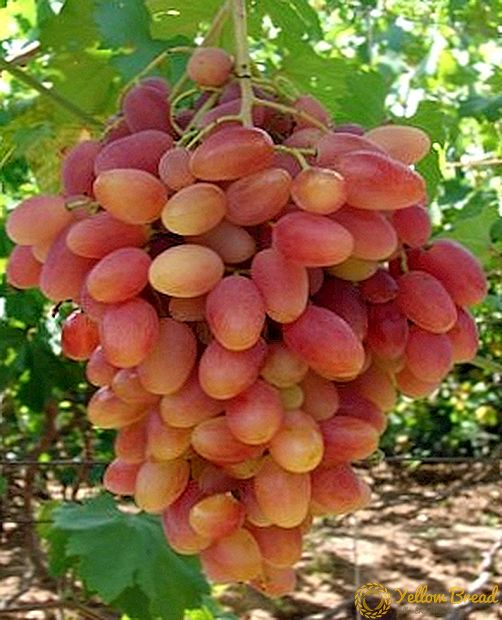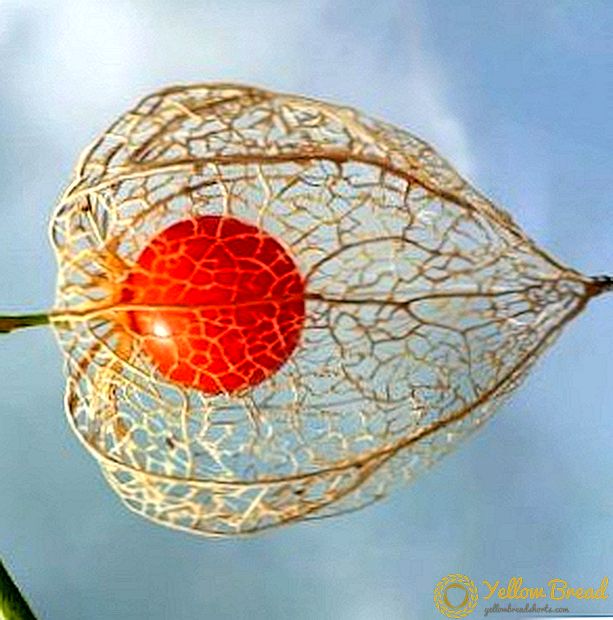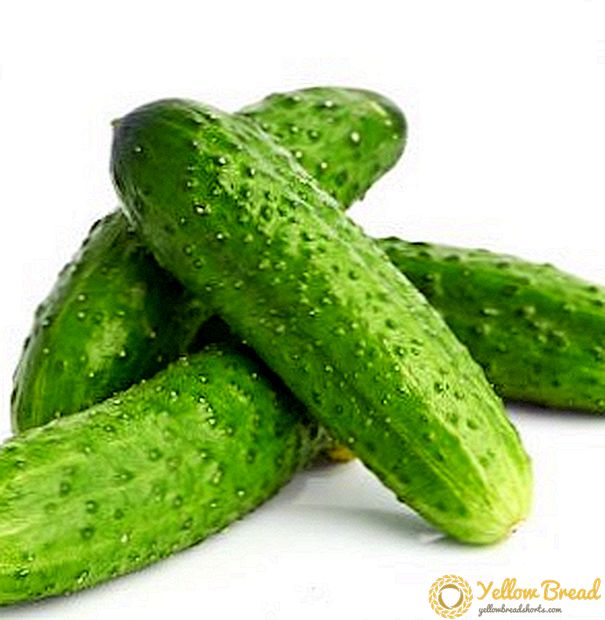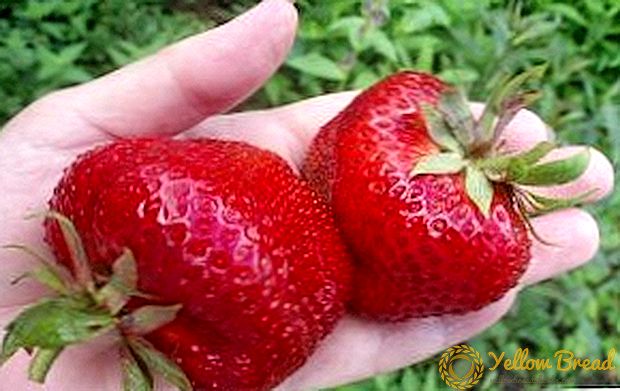 This variety is one of the most popular in our latitudes. Unpretentious care and excellent taste made him a favorite among many summer residents. In today's review, we will look at what is remarkable about the Zenga Zengana strawberry variety.
This variety is one of the most popular in our latitudes. Unpretentious care and excellent taste made him a favorite among many summer residents. In today's review, we will look at what is remarkable about the Zenga Zengana strawberry variety.
- Description of the variety
- Landing pattern
- How to choose seedlings
- Terms and place of landing
- How to plant "Zenga Zenganu"
- Strawberry Care Tips
- Watering, weeding and loosening the soil
- Fertilization
- Pest and disease control
- Trimming and removing whiskers
- How to prepare strawberries for winter
- "Zeng Zengana": the benefits of the variety
Description of the variety
The species belongs to plants of short daylight. The ripening period is medium late. Fruit buds appear on a short day (up to 12 hours). Flowering also occurs with a short light day (no more than 14 hours). The bush bears fruit once, closer to the middle of June, a month after flowering.
The variety is also distinguished by the fact that shoots in the form of "whiskers" are very actively developing, which makes it possible to compact the plantations. Bushes vigorous, with developed leaves, but quite compact. Berries are average in weight and size (10-30 g). The taste is very sweet, without acidity, with a thick skin.In the section visible bright red flesh.
Landing pattern
Thinking about purchasing seedlings, it is worth remembering some of the nuances associated with the cultivation of strawberries. Zenga has them too.
How to choose seedlings
You can buy strawberries both in the market and in nurseries. The following signs indicate a healthy plant:
- no damage in the form of breaks;
- well developed and whole rhizome;
- the bush has an elastic and strong core of green or light green color;
- the seedlings themselves are not sluggish and suitable for transportation;
- suitable seedlings are considered, in which the root neck reached 5-6 mm in diameter.
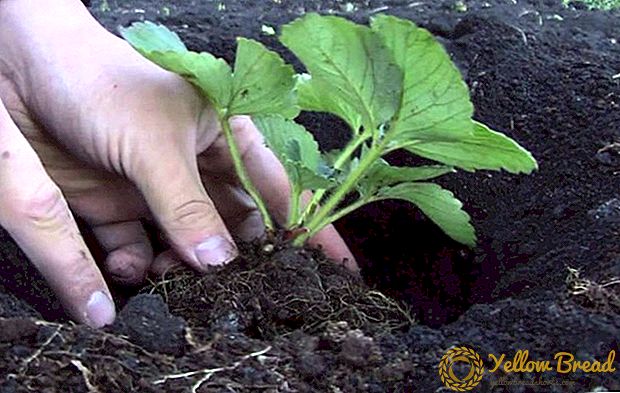 These simple rules will be the key to high yield.
These simple rules will be the key to high yield.Terms and place of landing
The best time for planting are the first decades of spring. In regions with a temperate climate, this is March 10-20. The variety tolerates easy frosts, therefore, it is not necessary to delay the planting.
The soil should be weed-free and healthy. Pre soil checked for pests. If there are any, a solution is used (2 kg of ammonia / 10 l of water) that is used to treat this area.
The soil itself for 2-3 weeks before planting will have to feed. As fertilizers, when digging, such compositions will be suitable (per 1 sq. M):
- rotted manure or humus (6 kg);
- potassium funds (20 g);
- superphosphates (40 g).
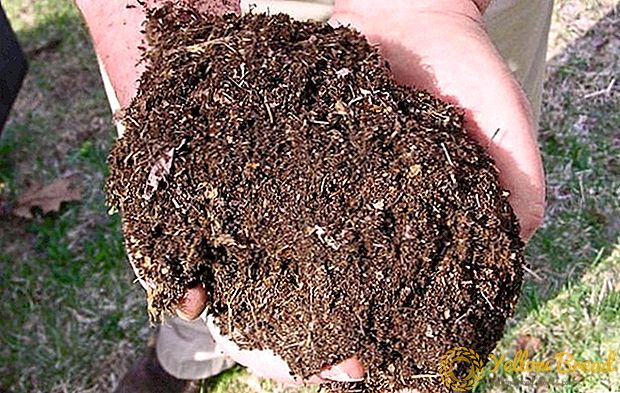 Another point is groundwater. It is desirable that they do not pass very high (the optimal depth is 60-80 cm).
Another point is groundwater. It is desirable that they do not pass very high (the optimal depth is 60-80 cm).How to plant "Zenga Zenganu"
Before planting, remove excess leaves, leaving a maximum of 3 leaves. This is done in order to reduce the evaporation area (this is how the moisture is held by the bush longer).
- having dug up small holes, they are poured with water;
- seedling is placed, gently pressing down the roots. The central kidney remains at ground level;
- gently cover with soil and pour plenty of well. If necessary, you can mumble.
The two-line scheme is a bit more complicated, the gap between the bushes is maintained there, but the rows go as if in two lines, while the same bushes of 70-80 cm are kept between the last bushes of different rows. but with obligatory mulching with black film. In order not to overheat the soil, straw is also placed on top. Note that this is a rather laborious approach.
Strawberry Care Tips
The variety is not without reason considered one of the most unpretentious. To see this, let's see how to care for planted bushes.
Watering, weeding and loosening the soil
Bushes are watered, depending on the weather: if there is no heat, then it is enough every 1-2 weeks. If the temperature is too high, then moisturizing is done every 5-7 days. Of course, the earth should not dry up to a state of stone, so look at the situation. The soil should soak 20-30 cm deep. 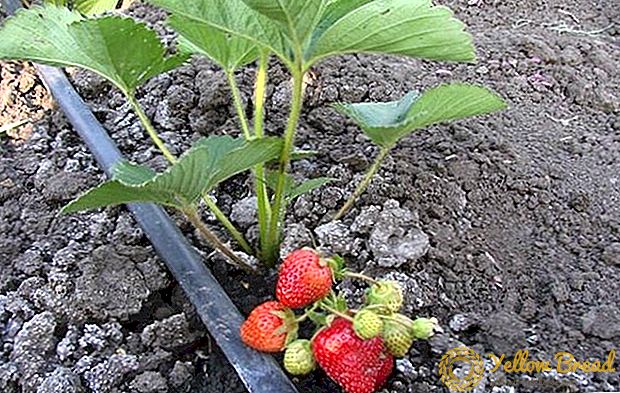 Here you need accuracy, try to water the hole so that the water does not fall on the green part of the bush. The best time is the morning hours.
Here you need accuracy, try to water the hole so that the water does not fall on the green part of the bush. The best time is the morning hours.
For strawberries, it is vital to moisten before flowering, then watering is carried out as needed.
Weeding is also required. Do not run weeds, it is better to remove them immediately.
With loosening the same story. The first few approaches are especially important when the soil is slightly “clogged” with melt water. Loosening in the aisle, going 10 cm. Near the bush take less, so as not to cut the roots. The bushes at the same time slightly spud (so adventitious roots are sprinkled). If the roots of old bushes are bare, this is no reason to panic - they are sprinkled with earth and gently spud.
Fertilization
The main thing is not to overfeed. Liquid formulations, and especially nitrogen, when making a large amount of work on the green mass, but not on the berries. Therefore, it is better to calculate the dose.
As soon as the leaves have gone to growth, the bush is watered with infused mullein with a small addition of sulfate.
To get a good harvest, use a urea solution. It is taken before flowering, diluting 2-30 g per liter of water. For this period, suitable and sulfate mixture: 1 tsp. potassium sulfate together with 2 tbsp. l nitroammofoski goes to 10 liters of water. On a bush pour about 0.5 liters of this composition.
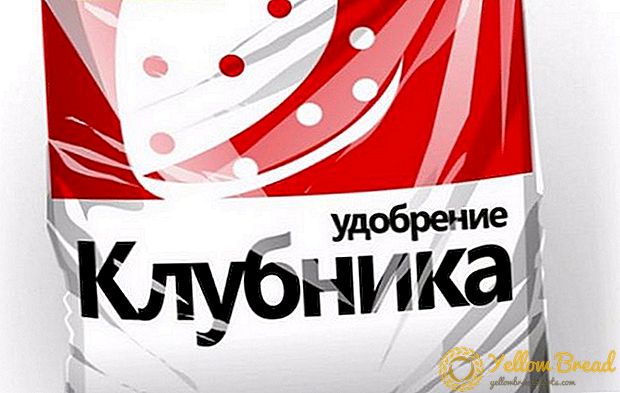 Liquid "organic" is also good, even infused chicken manure will help. In a small amount of water, it is insisted for 5 days, after which it is diluted with water in a ratio of 1:10. On 1 square. m make 3.5-6 liters of such funds.
Liquid "organic" is also good, even infused chicken manure will help. In a small amount of water, it is insisted for 5 days, after which it is diluted with water in a ratio of 1:10. On 1 square. m make 3.5-6 liters of such funds.Pest and disease control
Of the pests for "Zengi" strawberry mite is the most dangerous. It is resistant to Verticillus and powdery mildew. True, the danger can manifest itself in the form of leaf spot and gray rot.
It is not always possible to look at the tick (it is very shallow), therefore, before planting, it is often necessary to heat treat the seedlings.Planting material for 15-20 minutes is placed in a container with water warmed to 40 ° C, and then dried and planted.
They deal with spotting by different means depending on the color of the spots. Fungicides like Topaz, Horus or Golda are suitable for white lesions (if the disease is already widespread). Effective and iodine solution (50 ml / 10 l of water).
If the contaminated area has become large, spray it with a solution of mustard powder (50 g per 5 liters of warm water with a sediment of 2 days, after which 5 liters of cold water are added).
Such treatments are carried out at intervals of 10 days. The best time for this will be the start of shoot growth, budding and the first days after harvesting.
The Bordeaux liquid treatment, which is popular in such cases, is an effective, but quite dangerous measure. It is not always possible for plants to recover from its application, and if the dosage of a strong substance is incorrect, there is a risk of chemical burn.
At the forefront of prevention:
- clean beds;
- removal of affected bushes;
- competent and timely fertilization;
- spraying fungicidal solutions (spring and autumn);
- change of landing sites. They try not to keep strawberries in one place for more than 2-3 years.
Trimming and removing whiskers
There are no specific dates for removal. The only rule is that by the beginning of wintering strawberries should be cut, with young shoots fired in autumn.Many gardeners practice it in August. 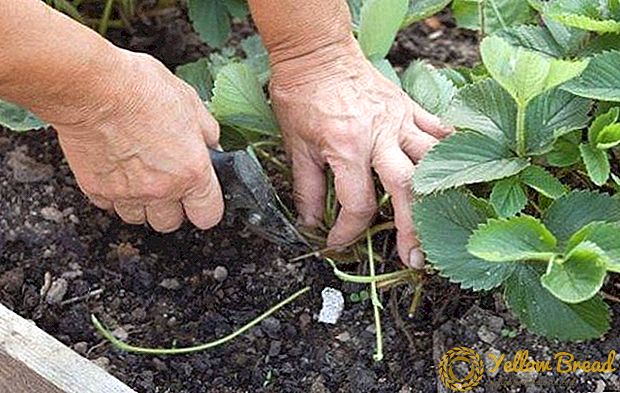
There are no difficulties here, but you need to know about these points:
- Use shears or scissors. You can not tear your hands.
- Clean only the leaf plates, not the sheet completely. Approximately 10 cm of stem is left (thereby maintaining the growth point for the next season).
- Antennae with a healthy rosette are left (if they go first from the bush). Such sockets drip.
- Only sick or sluggish leaves can be removed completely.
How to prepare strawberries for winter
Late autumn bushes covered. The material used for shelter depends largely on the weather in the region. So, for areas where winter is usually warm and snowy, a thick layer of mulch is enough. More frosty winters require more serious protection. 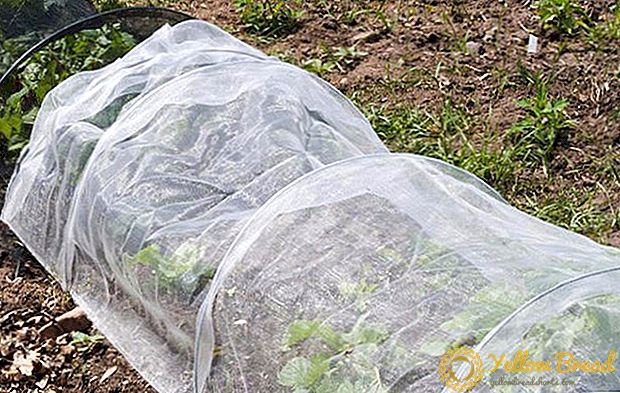 The most suitable material in such cases will be lapnik. Branches of coniferous trees completely cover the bushes of the first year, and more adult plants are laying around the circumference. For better air circulation under the needles you can put dry raspberry stalks or brushwood. And it is better to abstain from habitual leaves or tops - they are compressed and stopped, moreover they often become a wintering place for pests.
The most suitable material in such cases will be lapnik. Branches of coniferous trees completely cover the bushes of the first year, and more adult plants are laying around the circumference. For better air circulation under the needles you can put dry raspberry stalks or brushwood. And it is better to abstain from habitual leaves or tops - they are compressed and stopped, moreover they often become a wintering place for pests.
"Zeng Zengana": the benefits of the variety
Strawberries garden line "Zenga Zengana" suitable for gardeners who grow products for sale. The arguments in her favor will be:
- fragrant and delicious berries, which retain their qualities when frozen;
- the simplicity of the bush to the composition of the soil;
- adaptability to our conditions;
- relatively high immunity, resistance to a variety of fungal infections;
- high yield at the small sizes;
- for a long time keeps the presentation during transportation.
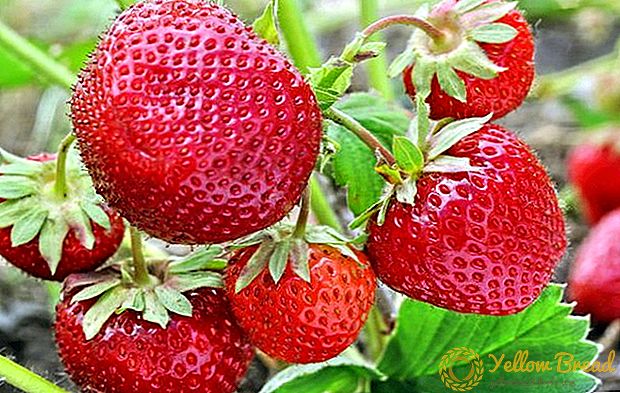 There are also disadvantages. For example, at the end of the period of fruiting the berries become smaller (you have to catch the moment). Another disadvantage is called susceptibility to gray rot. Although with proper care, this risk is significantly reduced.
There are also disadvantages. For example, at the end of the period of fruiting the berries become smaller (you have to catch the moment). Another disadvantage is called susceptibility to gray rot. Although with proper care, this risk is significantly reduced.
